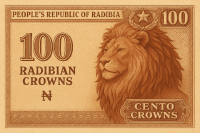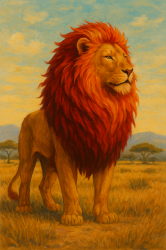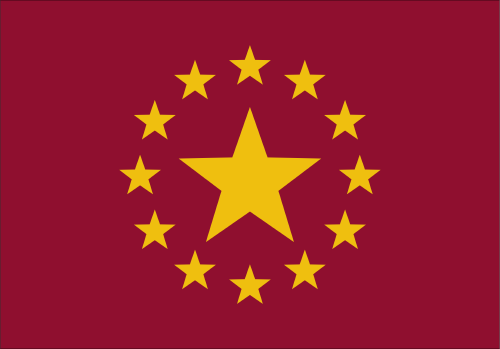| National Factbook |
| Flag: |

|
| Nation Name: |
Radibia |
| Leader Name: |
Richard Handerson |
| Currency: |

Radibian Crowns |
| National Animal: |

Radibian Firemane |
| History: |
Early Origins and Formation:
The land of Radibia was once a collection of feuding city-states, each ruled by warlords vying for control over its vast resources—fertile plains, deep forests, and mountain strongholds. In the early 18th century, a visionary leader named General Alaric Voss emerged, uniting the scattered territories under a single banner after decades of conflict. His ideals of equality and governance led to the founding of the People's Republic of Radibia in 1742, marking an era of prosperity and centralized rule.
Golden Age of Innovation (1800s-1900s)
As Radibia solidified its government, it became a hub for scholars and artisans. The construction of the Grand Archives in the capital, Valtross, showcased Radibia’s dedication to knowledge, housing centuries of literature, science, and magical research. Advancements in alchemy and mechanical engineering led to the creation of Radibia’s famed sky fleets, used for trade and defense.
Political Shifts and the Royal Revival:
Despite its firm republican foundations, Radibia experienced internal strife in the late 20th century. A charismatic nobleman, Richard Handerson, rose to prominence, claiming descent from a forgotten royal bloodline. Amid political turmoil, he seized power through a mixture of diplomacy and force, transitioning Radibia into a constitutional monarchy by 1998. His reign ushered in modern infrastructure and a renewed national identity, though tensions remain between traditional republican factions and monarchist loyalists.
Present Day:
Radibia now stands as a nation at the crossroads of its heritage—a republic turned monarchy, balancing ancient wisdom with contemporary progress. The people are divided on King Handerson’s rule, some praising his leadership, while others long for the democratic roots from which their nation grew. |
| Geography |
| Continent: |
Africa |
| Land Area: |
41,495.22 sq. km |
| Terrain: |
Savannah Plains: Much of Radibia is covered in vast, golden grasslands, where acacia trees dot the horizon and herds of wildlife roam freely. These plains serve as the agricultural heartland, providing fertile soil for farming.
Jagged Mountain Ranges: The Voss Peaks, named after Radibia’s founding father, form a formidable natural barrier in the north. These towering ridges are rich in minerals and hold ancient cave systems filled with historical relics.
Dense Rainforests: The Nyanga Grove in the south is a mysterious and lush rainforest, home to rare flora and fauna, as well as hidden villages untouched by modern civilization. Legends speak of powerful magical artifacts buried deep within its shadows.
Expansive Deserts: The Obsidian Wastes, stretching along the western frontier, are an arid, otherworldly desert with black sand dunes and hidden oasis towns. Nomadic tribes traverse this harsh environment, relying on deep-rooted survival traditions.
Great River Systems: The Zambari River, Radibia’s lifeline, cuts through the nation, providing sustenance and serving as a major trade route. Its banks are lined with bustling markets and historic settlements. |
| Highest Peak: |
Mt. Voss,
5,270 meters
|
| Lowest Valley: |
Zambari Gorge,
-320 meters
|
| Climate: |
Radibia experiences a variety of climates due to its geographical diversity. The north sees cooler mountain air, while the central plains have a warm, temperate climate. The rainforests bring heavy downpours, sustaining their dense ecosystems, whereas the western deserts face scorching heat during the day and freezing temperatures at night. |
| People & Society |
| Population: |
2,618,720 people |
| Demonym: |
Radibian |
| Demonym Plural: |
Radibians |
| Ethnic Groups: |
Radibi - 75.0%
Zambarans - 12.0%
Nyangan and Handerites - 13.0% |
| Languages: |
Radibian - 85.0%
Zambaran - 7.0%
Nyangan and Handeric - 8.0% |
| Religions: |
Vossanism - 42.0%
Zambari Animism - 28.0%
Handeric Monarchy Worship and Other - 30.0% |
| Health |
| Life Expectancy: |
72 years |
| Obesity: |
0% |
| Alcohol Users: |
0% |
| Tobacco Users: |
0% |
| Cannabis Users: |
0% |
| Hard Drug Users: |
0% |
| Economy |
| Description: |
The **economy** of the People's Republic of Radibia is diverse, shaped by its rich natural resources and strategic trade routes. It thrives on a mix of agriculture, industry, and commerce, making it one of the most influential economies in its region.
### **Key Economic Sectors**
- **Agriculture (32%)** – Radibia’s vast savannahs and river valleys provide fertile land for crops like sorghum, maize, and tropical fruits. Livestock farming is also a major contributor.
- **Mining & Resource Extraction (25%)** – The northern **Voss Peaks** are rich in minerals such as gold, copper, and rare gemstones, fueling Radibia’s mining industry.
- **Manufacturing & Technology (20%)** – Urban centers like **Valtross** specialize in textiles, industrial machinery, and emerging tech industries.
- **Trade & Commerce (15%)** – The **Zambari River** acts as a central trade hub, connecting Radibia to neighboring nations through exports of agricultural products and handcrafted goods.
- **Tourism & Culture (8%)** – Radibia’s landscapes, historic sites, and vibrant festivals attract visitors from around the world, boosting the service sector.
### **Economic System**
Radibia operates under a **mixed economy**, blending free-market principles with government-led development programs. King Richard Handerson’s administration has introduced policies to modernize infrastructure, increase exports, and strengthen international economic ties. |
| Average Yearly Income: |
$105.30 |
| Gross Domestic Product (GDP): |
$2,999,654,887.00 |
| GDP per Capita: |
$1,145.47 |
| Gross National Income (GNI): |
$1,748,294,885.00 |
| Industries: |
The People's Republic of Radibia boasts a thriving economy with several **major industries** that drive growth and innovation. Here are some of the most influential sectors:
### **1. Mining & Resource Extraction** (25%)
Radibia is rich in **gold, copper, and rare gemstones**, primarily found in the **Voss Peaks**. The mining sector is a cornerstone of the economy, fueling exports and supporting domestic industries.
### **2. Agriculture & Livestock** (32%)
Radibia’s expansive **savannahs and river valleys** provide fertile land for crops like **sorghum, maize, and tropical fruits**. Livestock farming—especially cattle and goats—is another significant contributor to food production and trade.
### **3. Manufacturing & Technology** (20%)
Urban centers such as **Valtross** have developed strong **textile, industrial machinery, and emerging tech** industries. Radibia is investing in modern **automobile assembly and sustainable energy solutions**, making it a hub for technological innovation.
### **4. Trade & Commerce** (15%)
The **Zambari River** serves as Radibia’s commercial lifeline, connecting it to neighboring nations for export and import trade. Handcrafted goods, textiles, and agricultural products are among the country’s biggest exports.
### **5. Tourism & Cultural Industry** (8%)
Radibia’s **historic sites, vibrant festivals, and stunning landscapes** attract global visitors. Safari tours in the **Nyanga Grove**, explorations of **Zambari Gorge**, and royal palace visits in **Valtross** contribute to a flourishing tourism sector.
These industries drive Radibia’s economic success, balancing tradition with innovation. |
| Military |
| History: |
The **Radibian Armed Forces (RAF)** serve as the backbone of national defense and regional security in the People's Republic of Radibia. Comprising several branches, the military maintains a balance between tradition and modernization.
### **Branches of the Radibian Armed Forces**
- **Radibian Army** – The largest branch, responsible for land-based defense, border security, and peacekeeping missions. It is known for its elite **Voss Guard**, trained in mountainous warfare.
- **Radibian Navy** – Operating along the **Zambari River** and coastal outposts, the navy ensures control over waterways, preventing piracy and facilitating trade security.
- **Radibian Air Corps** – Equipped with both conventional and magically enhanced aircraft, providing strategic aerial defense and rapid response capabilities.
- **Royal Guard** – An elite unit dedicated to the protection of King Richard Handerson, as well as safeguarding key government figures and the royal palace in **Valtross**.
### **Military Strength & Strategy**
Radibia employs a **strategic defense doctrine**, focusing on mobility, intelligence gathering, and diplomatic alliances. With its vast terrain, the armed forces integrate **guerrilla warfare tactics** in mountainous and forested regions, ensuring preparedness for external threats. |
| Soldiers: |
224,805 |
| Tanks: |
2,241 |
| Aircraft: |
585 |
| Ships: |
80 |
| Missiles: |
0 |
| Nuclear Weapons: |
0 |
| Last Updated: 05/29/2025 02:23 am |




















